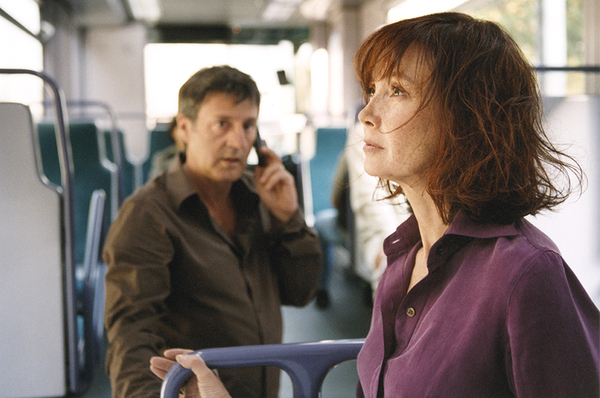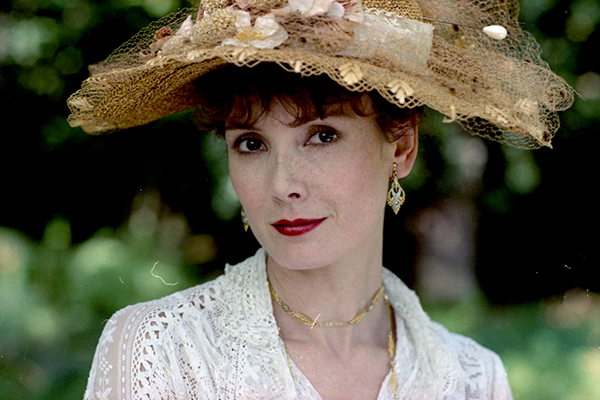The triple cadence of Sabine Azéma
PostED ON OCTOBER 7 AT 5 PM
“I am against discipline”, affirms photographer Robert Doisneau in the singular documentary produced in 1992 by Sabine Azéma, entitled Bonjour Monsieur Doisneau.
“I am against discipline” is also the mantra hidden behind each character played by Sabine Azéma.

Copyright David-Koskas
Being against discipline, not so much out of rebellion, but rather as a matter of rhythm; Sabine Azéma is too restless for discipline. She plays her roles without giving herself time to catch her breath. In nearly fifty films, the actress with the incandescent hair has built a career where, as Gérard Oury (with whom she shot two feature films: Vanille fraise, 1989, Le Schpountz, 1999) commented, “It is polite to be cheerful”. This cheerfulness has made her a luminous actress of comedies, fully embodying joy, enthusiasm, undisciplined surprise, especially in the social satires dear to Etienne Chatiliez (Happiness Is in the Field, 1995, Tanguy, 2001, Tanguy Is Back, 2019). This joy also contains its contrary, solemn gravity. The Lumière festival proposes that audiences (re)discover three visions of Sabine Azéma, through the lens of filmmakers Bertrand Tavernier, Alain Resnais, and Arnaud and Jean-Marie Larrieu.
It is impossible to evoke Sabine Azéma without thinking of Irène, the darling child of A Sunday in the Country by Bertrand Tavernier (1984). Her portrayal earned Azéma her first César for Best Actress in 1985, illustrating to what extent Tavernier, like an impressionist painter, works with nuances. Irène is the emancipated girl, who arrives, driving at breakneck speed, for a family get-together in the middle of a beautiful summer of 1912. Exuberant, Irène has time neither to catch her breath when she speaks, nor a second to let others get a word in edgewise. She has the courage of modernity, even if it sometimes means being unfair with her family. And if Tavernier seems to let Azéma-Irène deploy her contagious energy, his camera also follows her during moments when she is less breathless, where the silence of uncertainty sets in. In 1989, Sabine Azéma returns to work with Tavernier, for a serious and restrained role, in Life and Nothing But. Her character’s name is... Irène! She emerges like an antelope in the ravaged France of 1920, a sublime and fragile wife in the footsteps of her late husband. With her two Irènes, cinema sisters, or perhaps merged into the same character a few years later, Sabine Azéma delivers a dichotomy of expression, between fiery hopes and the practical will of women who take responsibility for their choices, and move on.

With Alain Resnais, for thirty years and in ten films, Sabine Azéma inhaled the deep waters of the mysterious search for happiness. In the films of Resnais, Azéma breaks her immediate frenetic pace of acting, and sits down to talk. She displays the tremor, the inner ebullience of passionate beings, wounded by love. She is notably the ardent Romaine in Mélo (1986), or the pious Charlotte with the delightful laughter in Private Fears in Public Places (2006). Between Mélo and Private Fears, two telling titles that outwardly brandish their themes, Sabine Azéma uses her breath, like a shy person who rushes to confess his or her desire to be in the world and the need to believe in it. Azéma embraces characters who are never sophisticated, but who, on the contrary, tend towards simplicity, in the hopes of being better discovered, whatever the outcome. The performance of the fantastic Romaine who escapes everything in Mélo, earned Sabine Azéma a second César for Best Actress in 1987.

In 2005, Sabine Azéma added yet another cadence to her acting upon entering the universe of variable meteorology of Arnaud and Jean-Marie Larrieu, with the impossible dilemma: To Paint or Make Love. With the two filmmaking brothers, all signs pointed to a story of sensual breathing, including for Madeleine, a peculiar bourgeoise played by Azéma, who "is fed up with painting still lifes" and discovers the mystery of the transgression of the senses. The actress adapted her breathing accordingly. No longer guided only by words, respiration overtook the entire body. Azéma transformed Madeleine into a woman ready for anything, like Irène(s), Romaine or Charlotte... far from discipline.
Virginie Apiou
Sabine Azéma
Meet Sabine Azéma on Wednesday, October 14 at the Comédie Odéon at 3:30pm
She will introduce also
A Sunday in the Country on Tuesday, October 13 at the Institut Lumière at 4:30 pm
Bonjour Monsieur Doisneau ou le photographe arrosé on Tuesday, October 13 at the Institut Lumière at 5:15 pm
Mélo on Thrusday, October 15 at the Pathé Bellecour at 6:30 pm
To Paint or Make Love on Friday, October 16 at the Cinéma Comœdia at 10:45 am
Private Fears in Public on Saturday, October 17 at the Institut Lumière at 4:30 pm

